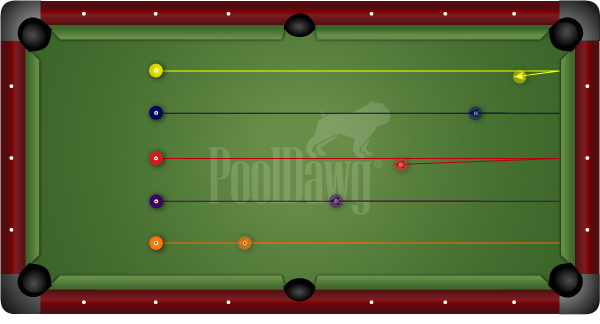We have covered why it is important to shoot softly before, the pockets play bigger, your fundamentals don’t deteriorate, and the cue ball doesn’t move around a lot. The less the cue ball moves, the easier it is for us to predict where it is going to wind up.
But what if we have to move the cue ball around the table? How do we learn how to control how far the cue ball goes? Let’s look at some things we can do that will develop the feeling for speed that we need in our arms to play excellent pool.
Take a look at this diagram:
Here is a great drill I learned from Bert Kinister a long time ago and still do once in a while. What you do is to roll the one ball to the end rail and bounce off a little. Next roll the two ball and bounce off the rail a little more. 5 balls is a good starting point. If that is too easy, do six; or if it is too hard, do 5.

It is also important that your cue ball comes straight back down the table. Not only are you developing the feeling of speed in your arm, but you are also working on rolling the cue ball straight by hitting it on the vertical axis. All foundational skills for your excellent pool game.
This drill will help you develop your normal standard game shots. Sometimes you have to roll the ball really slowly with control. This next drill will help you master that skill.
What you do is throw 5 or 6 balls out on the table in a random pattern. The goal is to roll the cue ball around the balls like an obstacle course. You can’t hit a rail and you can’t hit another ball! Keep track of how many shots it takes you to get around the course. The goal is to lower your score.
About now you might be asking yourself why I’m just rolling around one ball. That’s not how I play pool. Here is why.
When you cut a ball thinly, most of the energy stays in the cue ball. This means that your speed control problem is reduced to rolling the cue ball a specific amount, and that is exactly what we have been practicing!! Knowing this, it makes sense for us to play to our practiced strength and leave ourselves thinner cut shots when we have to move the cue ball.
Let’s look at an example:
In this problem, we would like to pocket the one ball and get good on the two so we can fall perfectly straight on the 3. That leads us directly to the 4 without having to do too much. We could stop on the one ball, but that leaves a straighter angle. Now pocketing the two is easier from there, but we have to juice up the cue ball to move it around the table and we are coming across the line of the 3. That doesn’t sound like a high percentage move.
We could also try to get straight on the two and draw back to get on the 3. We will be hitting the cue ball hard, the side pocket could grab our cue ball, if we over hit the shot we might wind up in the middle of the table and if we under hit the shot, we could be on the rail.
I like rolling forward on the one, taking a thinner shot on the two and rolling into position.